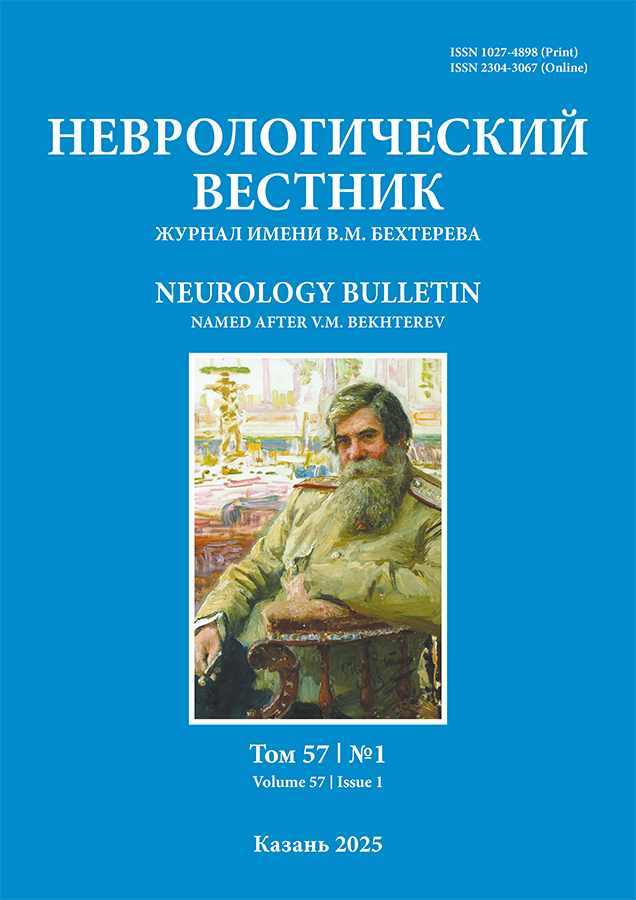Сравнительное исследование клинических и криминологических особенностей лиц с органическими психическими расстройствами и лиц с умственной отсталостью, совершивших повторные общественно-опасные деяния
- Авторы: Попов С.Н.1, Винникова И.Н.2, Хамитов Р.Р.3,4
-
Учреждения:
- Воронежский государственный медицинский университет им. Н.Н. Бурденко
- Федеральный медицинский исследовательский центр психиатрии и наркологии им. В.П. Сербского
- Казанская психиатрическая больница (стационар) специализированного типа с интенсивным наблюдением
- Казанский государственный медицинский университет
- Выпуск: Том LVII, № 1 (2025)
- Страницы: 20-26
- Раздел: Оригинальные исследования
- Статья получена: 23.10.2024
- Статья одобрена: 07.12.2024
- Статья опубликована: 15.03.2025
- URL: https://journals.eco-vector.com/1027-4898/article/view/637174
- DOI: https://doi.org/10.17816/nb637174
- ID: 637174
Цитировать
Аннотация
Обоснование. Изучение предикторов преступлений, совершаемых психически больными, в настоящее время остаётся одной из наиболее актуальных проблем в современной судебно-психиатрической профилактике. Широкий диапазон нозологических единиц требует изучения специфичных для каждой группы факторов, влияющих на криминальное поведение. Пациенты, страдающие умственной отсталостью, на сегодняшний день остаются наименее изученными в этой части.
Цель. Выявление репрезентативных криминологических признаков у пациентов с органическими психическими расстройствами и умственной отсталостью.
Материалы и методы. Дизайн: сравнительное исследование. Обследовано 110 пациентов, из которых 65 — с умственной отсталостью, 45 — с органическими психическими расстройствами. Все обследуемые совершили 2 и более правонарушения, были признаны невменяемыми и проходили принудительные меры медицинского характера различных типов. Источником данных являются результаты личного анкетирования и медицинские карты пациентов. Основные методы исследования — корреляционный и сравнительный анализ.
Результаты. Такие характеристики, как отсутствие криминального прошлого до первичного принудительного лечения (r +0,36, pi <0,01), возраст первого общественно-опасного деяния 15–19 лет (r +0,24, pi <0,01), продолжительность первичного принудительного лечения более двух лет (r +0,23, pi <0,01), неоднократные (3 раза и более) госпитализации в психиатрический стационар после окончания первичного принудительного лечения (r +0,34, pi <0,01) имели положительные корреляции с возможностью совершения повторного общественно-опасного деяния. Некоторые характеристики имели отрицательные корреляции с вероятностью совершения повторного общественно-опасного деяния: наличие нескольких эпизодов криминальных деликтов до первичного принудительного лечения (r +0,36, pi <0,01), возраст первого общественно-опасного деяния 30–40 лет (r −0,22, pi <0,01), длительность первичного принудительного лечения до одного года (r −0,73, pi <0,01), отсутствие госпитализаций в психиатрический стационар после окончания первичного принудительного лечения (r −0,37, pi <0,01). Наличие в анамнезе преступлений против собственности, а также жизни и здоровья имеет положительную корреляцию с аналогичным характером правонарушения при первичном общественно-опасном деянии (r +0,38, pi <0,05; r +0,32, pi <0,05 соответственно).
Заключение. Результаты исследования могут быть основой для дальнейшей разработки практических рекомендаций и инструментов в судебно-психиатрической профилактике в отношении пациентов, страдающих умственной отсталостью.
Полный текст
Об авторах
Сергей Николаевич Попов
Воронежский государственный медицинский университет им. Н.Н. Бурденко
Автор, ответственный за переписку.
Email: popovsn79@mail.ru
ORCID iD: 0009-0007-1890-8147
SPIN-код: 9942-5176
канд. мед. наук, доцент
Россия, ВоронежИрина Николаевна Винникова
Федеральный медицинский исследовательский центр психиатрии и наркологии им. В.П. Сербского
Email: IrVINa1@yandex.ru
ORCID iD: 0000-0002-7153-9834
SPIN-код: 5464-2215
д-р мед. наук, профессор
Россия, МоскваРустем Радикович Хамитов
Казанская психиатрическая больница (стационар) специализированного типа с интенсивным наблюдением; Казанский государственный медицинский университет
Email: rrkzn@mail.ru
ORCID iD: 0000-0002-1271-8330
SPIN-код: 4923-9370
д-р мед. наук, профессор
Россия, Казань; КазаньСписок литературы
- Vasyukov SA, Dvorin DV. Forensic-psychiatric assessment of mild mental retardation comorbid with syndrome of alcohol dependence. Russian Journal of Psychiatry. 2015;(4):17–24. EDN: UHCCWL
- Sannikov AG, Rodyashin EV, Tyurin MV, et al. The system of preventive measures against socially dangerous acts committed by psychiatric patients with mental retardation, based on identification, of factor and risk groups. Medical Science and Education of Ural. 2017;18(1):121–126. EDN: YOFKRF
- Rzhevskaya NK. Criminal aggression of persons with mental retardation [dissertation abstract]. Moscow; 2007. 16 р. (In Russ.)
- Shvab DV, Egorov DB, Kulevatov GV. An analysis of types of socially dangerous acts, committed by mentally retarded persons, as one of the foundations for crime prevention. Medical Science and Education of Ural. 2016;17(4):95–97. EDN YLPFDZ
- Shport SV, Makushkina OA, Mugantseva LA. Monitoring of indicators of the activity of the forensic psychiatric service of the Russian Federation (2018–2022). Moscow: FGBU NMICz PN im. V.P. Serbskogo Minzdrava Rossii; 2024. Р. 58–59. (In Russ.) EDN: EATEQQ
- Holland T, Clare IC, Mukhopadhyay T. Prevalence of criminal offending by men and women with intellectual disability and the characteristics of offenders: implications for research and service development. J Intellect Disabil Res. 2002;46 suppl 1:6–20. doi: 10.1046/j.1365-2788.2002.00001.x
- Holland S, Persson P. Intellectual disability in the Victorian prison system: Characteristics of prisoners with an intellectual disability released from prison in 2003–2006. Psychology, Crime & Law. 2011;17(1):25–41. doi: 10.1080/10683160903392285
- Bikel P, Doksam K. Mathematical statistics. Moscow; 1983. (In Russ.)
- Loyd EL, Lederman, YN, editors. Handbook of Applied Statistics. Moscow: Finance and Statistics, 1989. (In Russ.)
Дополнительные файлы









